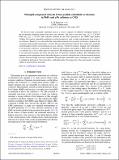Principal-component analysis of two-particle azimuthal correlations in PbPb and and pPb collisions at CMS
Author(s)
Allen, Brandon Leigh; Abercrombie, Daniel Robert; Azzolini, Virginia; Barbieri, Richard Alexander; Baty, Austin Alan; Bi, Ran; Brandt, Stephanie Akemi; Busza, Wit; Cali, Ivan Amos; D'Alfonso, Mariarosaria; Demiragli, Zeynep; Gomez-Ceballos, Guillelmo; Goncharov, Maxim; Hsu, Dylan George; Iiyama, Yutaro; Innocenti, Gian Michele; Klute, Markus; Kovalskyi, Dmytro; Lai, Yue Shi; Lee, Yen-Jie; Levin, Andrew Michael; Luckey Jr, P David; Maier, Benedikt; Marini, Andrea Carlo; McGinn, Christopher Francis; Mironov, Camelia Maria; Narayanan, Siddharth Madhavan; Niu, Xinmei; Paus, Christoph M. E.; Roland, Christof E; Roland, Gunther M; Salfeld-Nebgen, Jakob Maxillian Henry; Stephans, George S. F.; Tatar, Kaya; Velicanu, Dragos Alexandru; Wang, Jing; Wang, Ta-Wei; Wyslouch, Boleslaw; ... Show more Show less
DownloadPhysRevC.96.064902.pdf (699.9Kb)
PUBLISHER_CC
Publisher with Creative Commons License
Creative Commons Attribution
Terms of use
Metadata
Show full item recordAbstract
For the first time a principle-component analysis is used to separate out different orthogonal modes of the two-particle correlation matrix from heavy ion collisions. The analysis uses data from √s[subscript NN] = 2.76 TeV
PbPb and √s[subscript NN] = 5.02 TeV pPb collisions collected by the CMS experiment at the CERN Large Hadron Collider. Two-particle azimuthal correlations have been extensively used to study hydrodynamic flow in heavy ion collisions. Recently it was shown that the expected factorization of two-particle results into a product of the constituent single-particle anisotropies is broken. The new information provided by these modes may shed light on the breakdown of flow factorization in heavy ion collisions. The first two modes (“leading” and “subleading”) of two-particle correlations are presented for elliptical and triangular anisotropies in PbPb and
pPb collisions as a function of pT over a wide range of event activity. The leading mode is found to be essentially equivalent to the anisotropy harmonic previously extracted from two-particle correlation methods. The subleading mode represents a new experimental observable and is shown to account for a large fraction of the factorization breaking recently observed at high transverse momentum. The principle-component analysis technique was also applied to multiplicity fluctuations. These also show a subleading mode. The connection of these new results to previous studies of factorization is discussed.
Date issued
2017-12Department
Massachusetts Institute of Technology. Department of Physics; Massachusetts Institute of Technology. Laboratory for Nuclear ScienceJournal
Physical Review C
Publisher
American Physical Society
Citation
Sirunyan, A. M., et al. “Principal-Component Analysis of Two-Particle Azimuthal Correlations in PbPb and p Pb Collisions at CMS.” Physical Review C, vol. 96, no. 6, Dec. 2017. ©2017 CERN, for the CMS Collaboration
Version: Final published version
ISSN
2469-9985
2469-9993